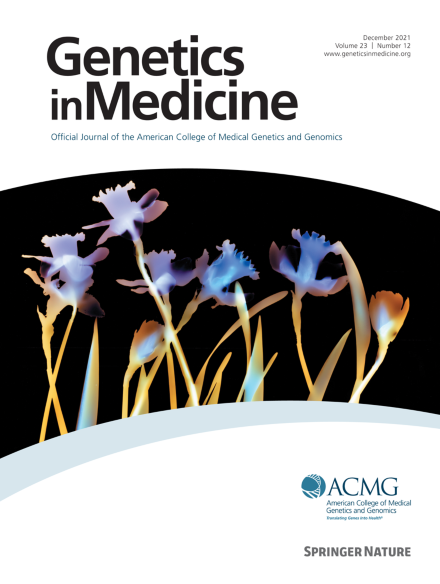Recognizing the evolution of clinical syndrome spectrum progression in individuals with single large-scale mitochondrial DNA deletion syndromes (SLSMDS)
IF 6.2
1区 医学
Q1 GENETICS & HEREDITY
引用次数: 0
Abstract
Purpose
Single large-scale mtDNA deletions (SLSMD) result in single large-scale deletion syndromes (SLSMDS). SLSMDS presentations have classically been recognized to encompass at least 3 distinct clinical phenotypes: Pearson syndrome (PS), Kearns-Sayre syndrome (KSS), and chronic progressive ophthalmoplegia.
Methods
A facilitated review of electronic medical records, manual charts, and Research Electronic Data Capture research databases was performed to complete a retrospective natural history study of 30 participants with SLSMDS in a single health system between 2002 and 2020. The evaluated characteristics included genetic and clinical laboratory test values, growth parameters, signs and symptoms, demographics, and patient-reported outcome measures of fatigue, quality of life, and overall function.
Results
Detailed cohort characterization highlighted that a recurrent deleted region involving MT-ND5 (HGNC:7641) occurs in 96% of participants with SLSMDS regardless of the clinical phenotype, which tends to evolve over time. Higher blood heteroplasmy correlated with an earlier age of onset. Growth differentiation factor 15 levels were elevated in all participants with SLSMDS. A history of PS was associated with poor survival prognosis. Furthermore, increased fatigue and decreased quality of life have been reported in patients with SLSMD with advanced age.
Conclusion
A retrospective natural history study of patients with SLSMDS demonstrated the evolution of classically considered PS, Kearns-Sayre syndrome, and chronic progressive ophthalmoplegia clinical presentations in affected individuals, which may inform future clinical trial developments.
认识单个大规模线粒体DNA缺失综合征(SLSMDS)个体临床综合征谱进展的演变。
单次大规模mtDNA缺失(Single Large Scale Deletion, SLSMD)导致单次大规模缺失综合征(Single Large Scale Deletion syndrome, SLSMDS)。SLSMDS的表现通常被认为包括至少三种不同的临床表型,Pearson综合征(PS), Kearns-Sayre综合征(KSS)和慢性进行性眼麻痹(CPEO)。方法:对电子病历、手工图表和REDCap研究数据库进行了方便的回顾,以完成对2002年至2020年在单一卫生系统中30名SLSMDS参与者的回顾性自然病史研究。评估的特征包括遗传和临床实验室测试值、生长参数、体征和症状、人口统计学以及患者报告的疲劳、生活质量和整体功能的结果测量。结果:详细的队列特征强调,96%的SLSMD受试者中存在涉及MT-ND5的复发性缺失区域(HGNC:7641),无论临床表型如何,该区域都倾向于随着时间的推移而进化。血液异质性越高,发病年龄越早。所有SLSMD患者GDF-15均升高。PS病史预后为阴性。此外,随着年龄的增长,SLSMD受试者的疲劳增加和生活质量下降。结论:对SLSMDS患者的回顾性自然病史研究表明,传统认为的PS、KSS和CPEO临床表现在患者体内的演变,可能为未来的临床试验开发提供信息。
本文章由计算机程序翻译,如有差异,请以英文原文为准。
求助全文
约1分钟内获得全文
求助全文
来源期刊

Genetics in Medicine
医学-遗传学
CiteScore
15.20
自引率
6.80%
发文量
857
审稿时长
1.3 weeks
期刊介绍:
Genetics in Medicine (GIM) is the official journal of the American College of Medical Genetics and Genomics. The journal''s mission is to enhance the knowledge, understanding, and practice of medical genetics and genomics through publications in clinical and laboratory genetics and genomics, including ethical, legal, and social issues as well as public health.
GIM encourages research that combats racism, includes diverse populations and is written by authors from diverse and underrepresented backgrounds.
 求助内容:
求助内容: 应助结果提醒方式:
应助结果提醒方式:


